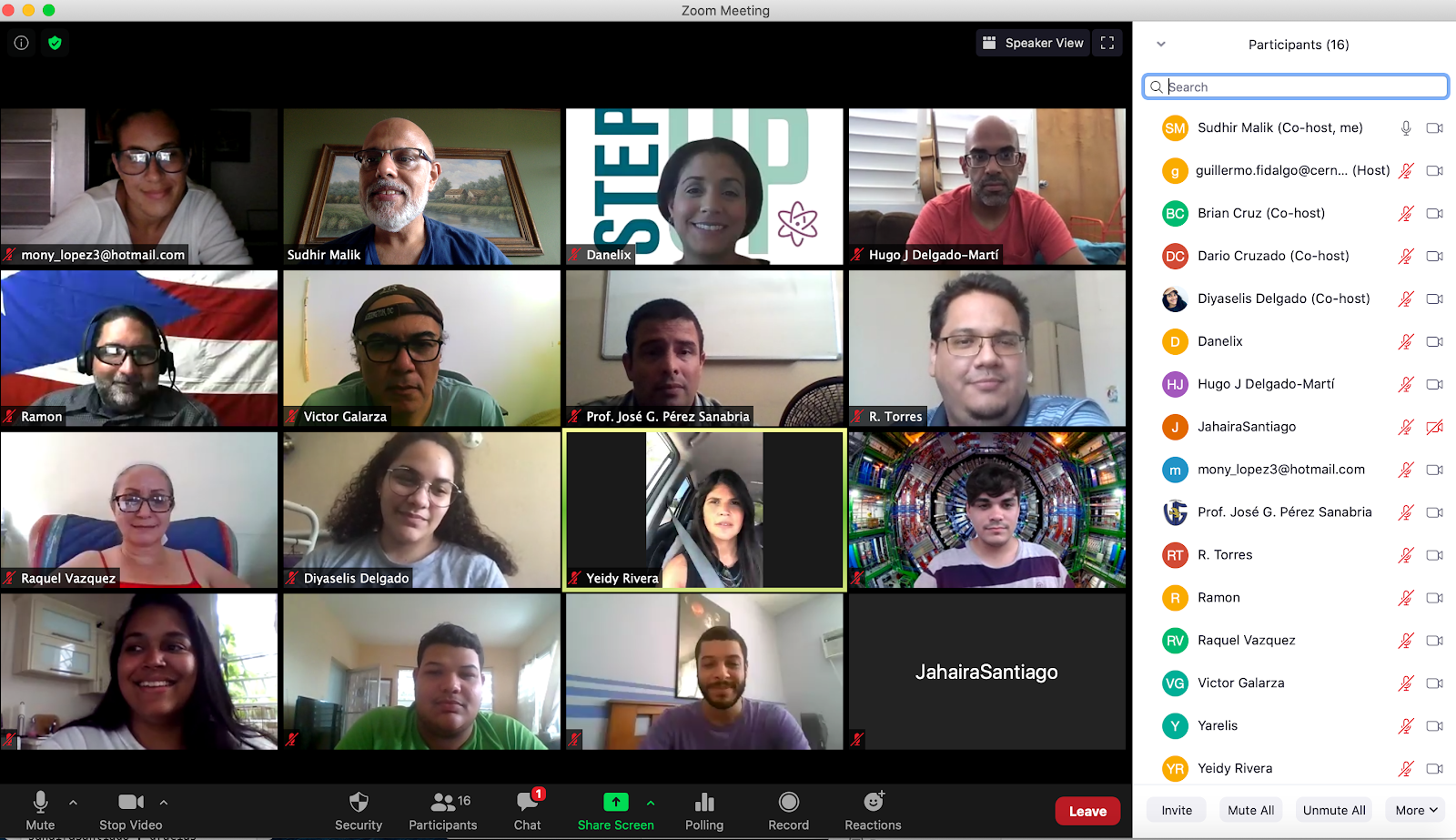Though many laboratories came to a halt this spring as the COVID pandemic forced people across Europe and North America to stay home, research at IRIS-HEP kept moving forward. Work at IRIS-HEP looked different, and some researchers put their work on hold – whether forced by the pandemic itself, or to help with the scientific and technical response to the crisis – but the institute itself continued moving towards its goal: preparing the software at CERN’s Large Hadron Collider for the deluge of data flowing from its detectors during the “high-luminosity” era, starting in 2027.
Central to that work is the education, training, and outreach programs run by Sudhir Malik, the institute’s training, education, and outreach coordinator and a Professor of Physics at the University of Puerto Rico at Mayaguez” IRIS-HEP comes from the notion that the high-luminosity LHC will require not just a hardware upgrade, but a software upgrade too,” says Peter Elmer, the institute’s PI and Executive Director. Researchers are working to accelerate particle tracking programs, upgrade data storage and retrieval systems, and build new algorithms for analyzing data. “That means preparing the software and computing necessary for that, but it also means building a community of researchers who have a stake in making this effort work.”
Training for a remote future
Malik runs several workshops a year aimed at teaching various practices in software engineering, algorithms, and data handling to IRIS-HEP researchers and others collaborating with the institute. These programs are typically in-person, so Malik had to first postpone the spring’s programming, and then transition it to virtual. “The idea is to do six to eight of these every year,” says Malik, so the institute very quickly had to “figure out how to keep doing them every month or two.”
Since March, Malik and the rest of the training team have run four virtual training sessions, on topics from python programming for STEM teachers to robust analysis tools like Docker and Continuous Integration/Continuous Development (CI/CD). Trainees – ranging from first-year PhD students to postdocs – alternated between morning lectures and afternoons, when they worked on their own projects with mentors at the ready, regrouping at the end of the day to discuss outstanding questions and issues. “Even before, when we were in classrooms, most people at the trainings were glued to their laptop anyway, logged into a machine at Fermilab, say, or CERN, “says Malik. “The one component that we thought was challenging was ensuring that everyone had the prompt person-to-person help they might need during the training. That was well-compensated by the collaboration tools we had like Mattermost and Zoom.
The morning lectures were professionally recorded, giving students high-quality instructional material to learn from, and giving IRIS-HEP the beginnings of a structured curriculum for teaching software-engineering for high-energy physicists. Combining the recorded trainings with virtual support from other instructors will allow trainees to learn the skills they need to successfully contribute to IRIS-HEP, whatever skill level they’re entering the collaboration with. In the next few months, the team will run trainings on machine learning and data preservation, continuing to build the institute’s skills for the future.
“We were afraid, but I think it worked out,” says Malik. “COVID is a bad, bad thing, but it was good that we tried this alternative, and now an all-online training model is something we’ll try to interleave with in-person training.
From Austin to Online
Virtual classes are one thing, but an entire virtual conference is another challenge entirely. This is just what Henry Schreiner and Jim Pivarski, computational physicists at Princeton, had to do when SciPy, the annual conference for scientific Python programming, went virtual just two months before it was planned to be held in Austin this July. Pivarski and Schreiner organize PyHEP – a conference for python programming specifically in high-energy physics. This year, it was to be held in Austin overlapping with SciPy, but they had already been considering the contingency of holding a virtual conference.
“When SciPy went virtual, that cemented it,” says Schreiner.

A screenshot showing participants of the US-ATLAS Computing Bootcamp 2020, held from August 24-28, 2020.
Despite the similar phrasing, running a conference virtually bears no resemblance to running software virtually, says Pivarski. “A virtualized computer program doesn’t know it’s running in a container because the environment is perfectly replicated – but at a virtual conference, the environment is very different and all the participants are aware of it all the time.” Virtual PyHEP, for instance, spread its programming out over two time-zone windows, one that was best for attendees in Europe, Africa, and the Americas, and the other for attendees on the pacific coasts of Asia, Australia, and North America.
“The HEP community has a lot of meetings virtually, but by holding the conference concurrently with SciPy, we were hoping to gain a lot of productive coffee conversation that we don’t have at other meetings,” says Schreiner. In some ways, the conference lacked that – participants could converse over Slack and ask questions after presentations, but there was no physical or virtual space that mirrored the break room. But in other ways, PyHEP 2020 was an unparalleled success: demand was so high that attendance had to be capped at 1000, a 10-fold increase from previous PyHEP meetings.
“In surveys after the conference, it was very clear that, if it were in-person, many attendees would not have had the funding to travel to the conference – we reached a lot of graduate students and young postdocs,” says Pivarski. “Pandemic or not, we may do future PyHEPs always online.”
The Future of Software Training
“Software is this funny thing,” says Elmer. “There isn’t a solid, universal training when people are undergraduates or in the first part of graduate school.” In response, IRIS-HEP continues to build its own training for a world where “you can’t do science without software anymore,” says Elmer – and this year, for one where you can do software research from anywhere.
